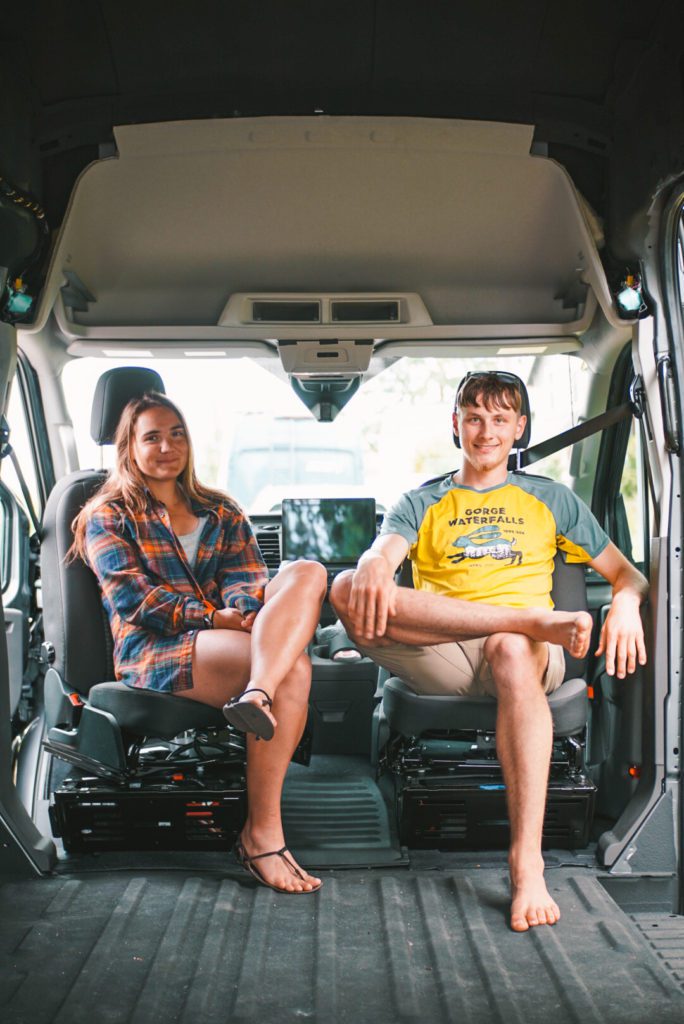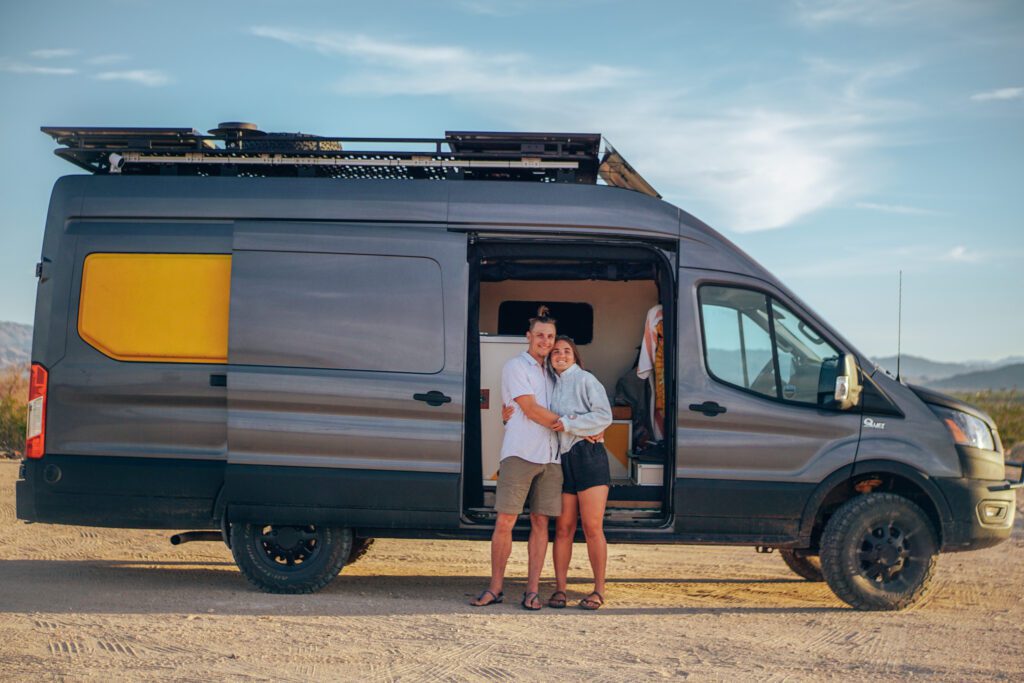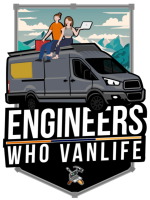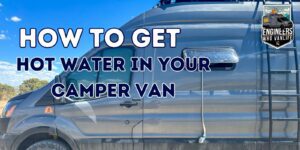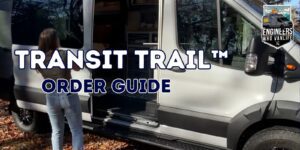Everything You Need to Know to Do Van Life in Alaska
Alaska is one the best, and biggest, treks van lifers will make. We made the trek for 10 weeks in the Summer of 2023. When we were preparing, there was little information out there for us to go off of, so we wanted to create this free guide to help you plan, and hopefully inspire you to add Van Life Alaska to your list.
Welcome to the Ultimate Guide to Van Life in Alaska! If you have additional questions, drop them in the comments and we will get to them ASAP.
In This Guide:
Overview Map for Van Life Alaska
Before we dig into the logistics of van life in Alaska, we made to give you a visual of the state. This is not “to-scale”, rather this is our mental model that helped us get around the state! As you can see, a majority of what you will do is in the south of Alaska and near the coast.
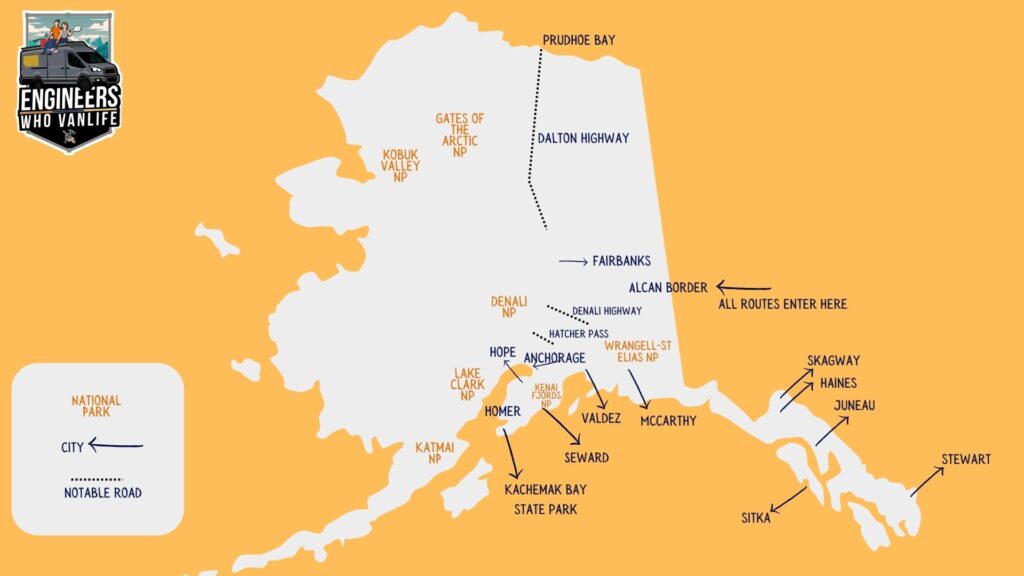
What is van life like in Alaska?
Van Life in Alaska is potentially the best type of van life that exists:
- The weather is mild
- Water and dump stations are widely accessible
- Overnight spots are aplenty
- The scenery is stunning
- Adventure is around every corner
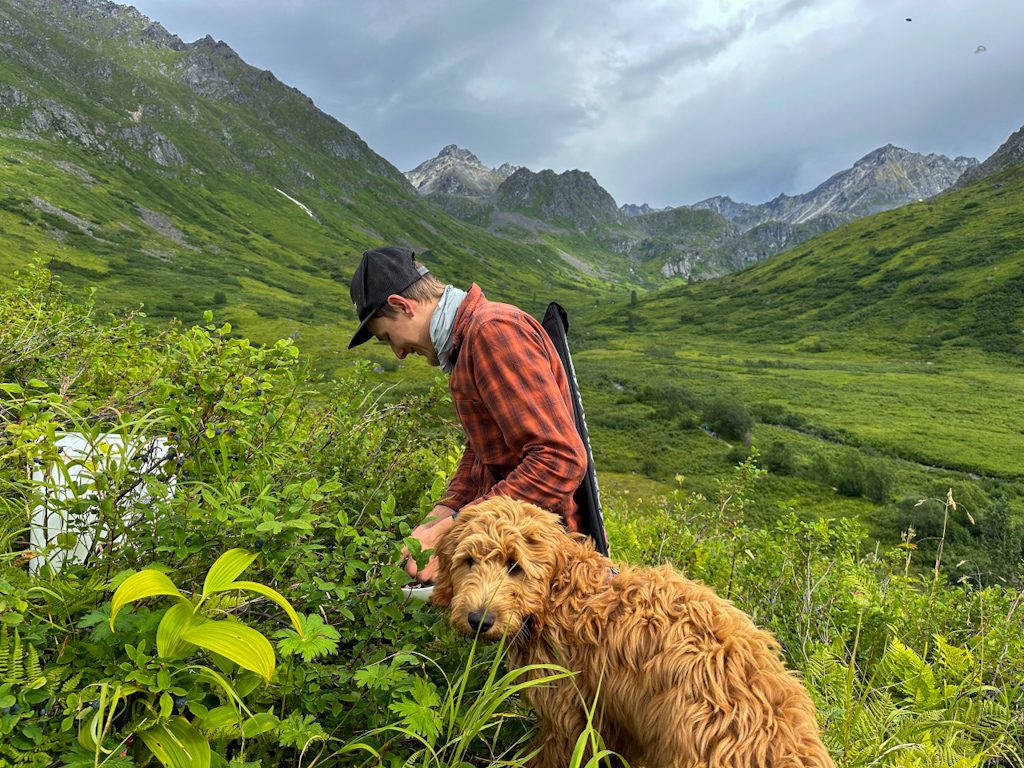
Preparing for Van Life in Alaska
Our guide will prepare you for what to expect, and what to do, as a van lifer in Alaska. However, we also want to recommend purchasing The Milepost to help you with detailed route preparation.
We will share our recommendations, but there is no better guidebook we have ever seen (for any place) than this book. We used our copy almost every day!
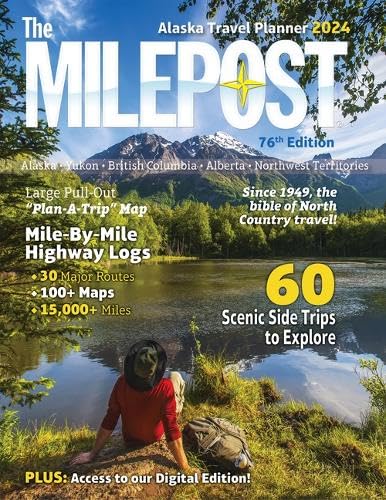
** Disclaimer: This blog post contains various affiliate links that provide a small kickback to us, at no additional cost to you. We truly appreciate your support if you choose to purchase through these! **
How long does it take to drive to Alaska from the Lower 48?
Anywhere from 3 days to weeks. We personally drove straight through Canada due to work restrictions. The fastest we made it was 3 days on the way down. This was not the most enjoyable journey as it basically involved sleeping and driving. Most van lifers opt to take a few weeks to do this drive, and if you have the time, we absolutely recommend that method.
On the way up to Alaska, in early summer, you will have A LOT of daylight to play with for driving late into the night. The longest day of sunlight will be late June with a little over 19 hours. However, on the way back south, you will have between 14-16 hours of sunlight. We generally recommend only driving during daylight hours due to the large amount of bear and moose.
Let’s talk route options for getting to Alaska from the Lower 48!
Route Options: Lower 48 -> Alaska
Getting to Alaska can be as much of a journey as being there! There are three main ways to get there from the Lower 48; the first two are by car (camper van!), and the third option involves a ferry.
The two driving routes split at Prince George, British Columbia and then come back together near Watson Lake in the Yukon. The “AlCan”, or Alaska Canada Highway goes right, and the Cassiar Highway goes left.

1. The Alaska Canada Highway
The standard “AlCan Highway” or “The Alaska Canada Highway” runs from Dawson Creek, BC to Delta Junction in Alaska. The route meets up with the Cassiar Route in the Yukon near Watson Lake.
This is the most common route. If you are looking to take it slow and have more attractions, or even just company on the road, this is the route to take. Fuel stations are also less of a concern on this route.
2. The Cassiar Highway
The Cassiar Highway is about 100 miles shorter than The Alaska Canada Highway; however, it is slower going, and much more remote. With all of that said though, it is a more scenic route on which you will have more solitude.
On this route, it is important to pay attention to the fuel station distances and your camper vans fuel range. The longest you will have to make it without a fuel station is 148 miles. However, fuel stations may close, or run out of fuel. We took the below photo at the beginning of the Cassiar Highway that shows facilities. We recommend saving it to your camera roll as their will be no cell signal along the entire highway.
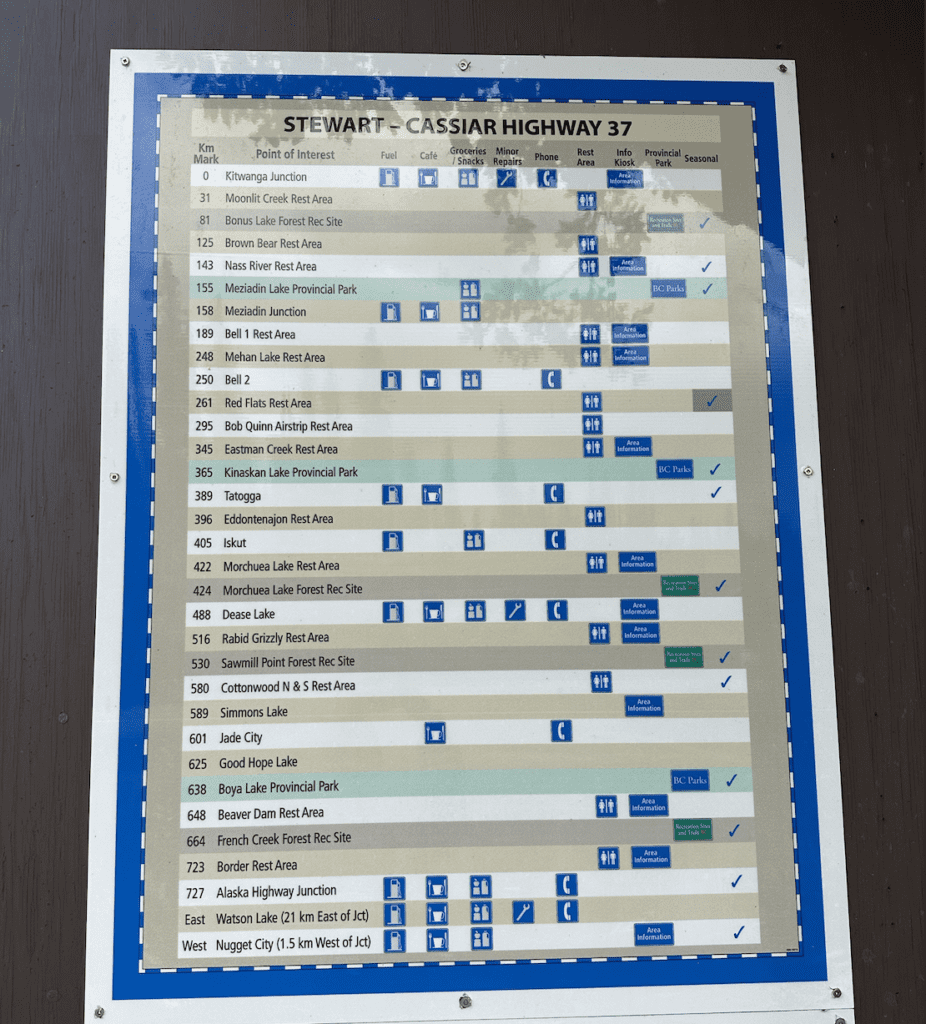
3. Alaska Marine Highway Ferry
If driving sounds overwhelming, you can get your camper van to Alaska via the Marine Highway Ferry! This vehicle and passenger ferry runs from Bellingham, Washington to several ports in Alaska. Most van lifers will get on the ferry in Bellingham, WA and off in Haines, Alaska. From there, you will have to continue to drive into mainland Alaska (about 700 miles to Anchorage).
The ferry route from Bellingham to Haines takes about 2.5 days.
Cost
Taking the ferry will not save you money compared to driving to Alaska. When we quoted our 21ft camper van with 2 adults from Bellingham to Haines it was $2,245. This is without a cabin add on. However, it does save you the actual driving and you will have some beautiful scenery along the way.
One way to save money would be to camp on the ship deck. You can opt to not pay for a cabin and instead bring your camping gear and camp for free on the ship deck with your fellow nomads!
Pets
Pets are one of the main reasons people opt to drive instead of ferry to Alaska. If on the ferry, your pet must remain in your vehicle on the car deck and “pet calls” are made every 8 hours for 15 minutes to let you attend to your pet.
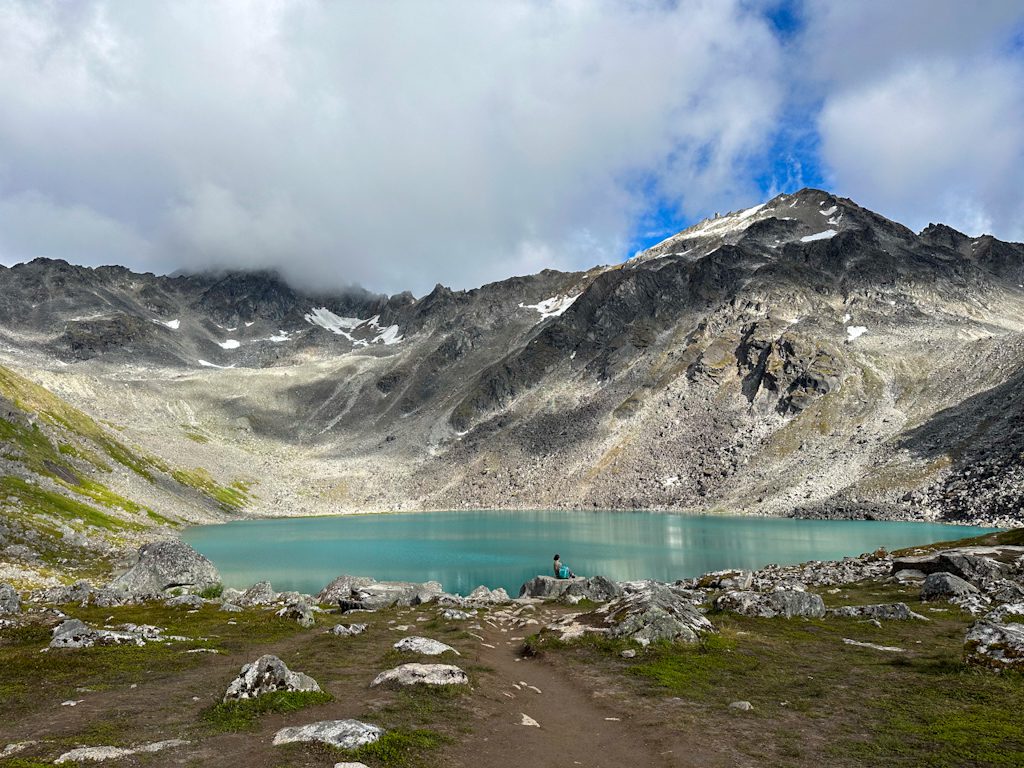
What are the roads like in Alaska?
One of the main differences between Alaska and the Lower 48 is the lack of “side Forest roads” that most van lifers rely on. There is pretty much one main Highway that goes through Alaska and a majority of camping spots are small pullouts directly off of this main road. There are very few Forest Roads to drive down and camp off of.
The main Highway system is well taken care of. However, the one thing to look out for are frost heaves – the upward displacement of pavement due to ice beneath it. These can send your van on some serious jumps! The worst road conditions and frost heaves that we witnessed were the150 miles on either side of the Alaska – Canada border.
Below you can see the conditions of a rare small spur we took off of the main Highway down to a campsite. Roads like these are almost always overgrown, rocky, and steep. However, you can completely avoid these and find great “pull of” campsites along the main Highway system.
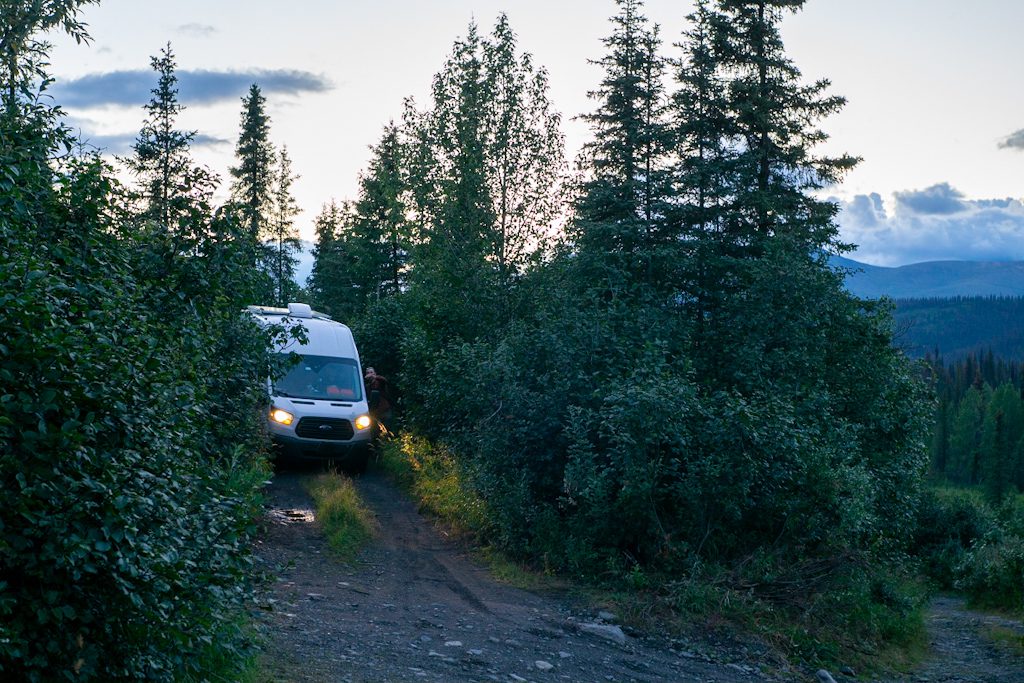
Van Life Logistics in Alaska
Alaska is absolutely beautiful everywhere you look. However, we also recommend it for van lifers because it is truly incredibly easy to do van life there:
- Water is widely available
- Weather is mild
- Residents have no issues with you camping in your vehicle
Overnight Camping Spots
A lot of van lifers are shocked to learn that most of the beautiful camping spots they see are simply pullouts along the main Highway system. Forest Roads like we have down in the Lower 48 are not popular there. However, with that said, camping spots are very easy to come by, and the van lifestyle is widely accepted in Alaska.
Some of our favorite campsites were trailheads to epic hikes and scenic overlooks. IOverlander is your friend in Alaska.
Solar Power
Solar Power is hit or miss in Alaska. In the Summer, temperatures are comfortably mild, but rain is fairly common. That, in addition to the lower solar angle from being so far north, makes solar power something you can’t fully rely on for power. We recommend having a DC-DC charger, or shore power capability if you want to van life in Alaska. This will allow you to charge your battery bank various ways.
If you are interested in learning all about Solar Power in Camper Vans, head on over to our dedicated guide!
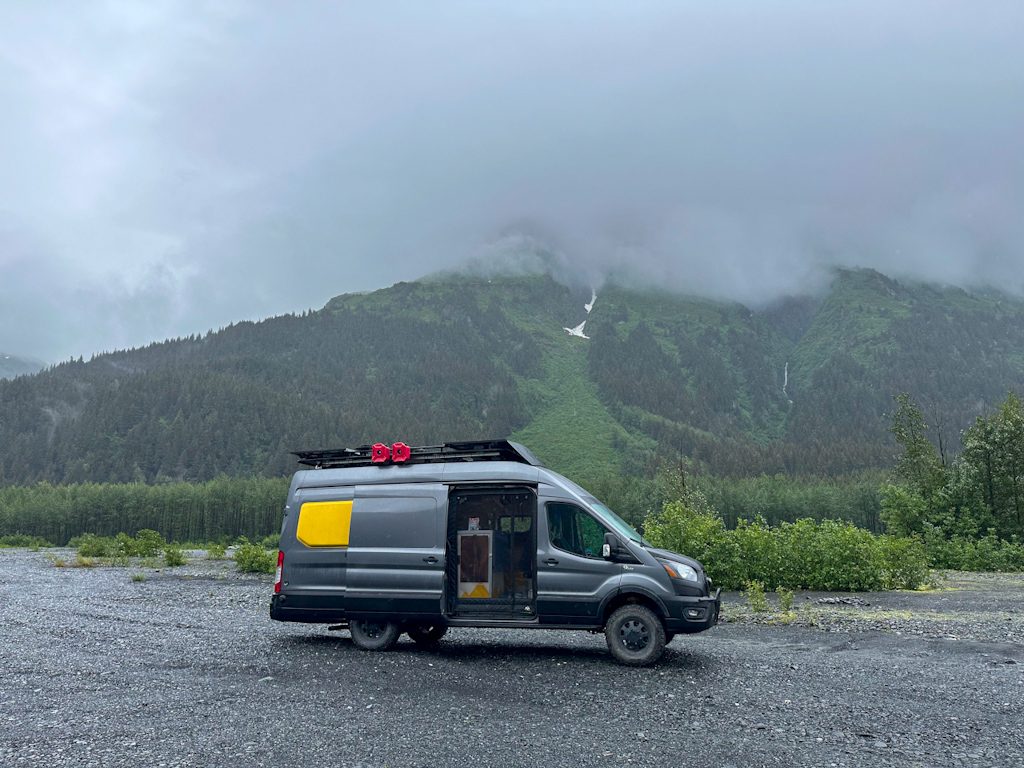
Water Fills & Dump Stations
Water and Dump Stations are plentiful in Alaska! We often found ourselves stumbling upon potable water fill ups accidentally which has never happened to us before.
Bonus! If you are like us and prefer to fill from fresh water sources, Alaska is THE place to do this. The glacier run off is incredible. Prior to embarking on this trip, we built a system that utilizes our on board water pump to pressurize natural water sources and filter it at the same time, check out the full schematics here!
What is the weather like in Alaska in the Summer?
Temperatures are extremely mild ranging from 45F to 70F on average. However, Alaska is very rainy in the Summer. We always say, there is no bad weather, just bad preparation. So, just pack your best rain gear and maybe grab a pair of Xtratufs!
What additional gear do you need for van life in Alaska?
Van Life in Alaska is much more remote and raw than most folks have experienced. We stocked our camper van with the following before heading up and it all came in handy:
- The Milepost Guide Book
- Spare fuel canisters (filled of course)
- Bug Screens (We cover DIY & Professional options here)
- Garmin InReach Mini (or satellite messenger of choice)
- Rain Gear 🙂 We love our xtratuf boots
- Recovery Boards – We prefer GoTreads because they double as leveling blocks.
- Tire Inflators
- Tire Deflators
Internet / WiFi Considerations for Van Life in Alaska
We continued to work full time while in Alaska. However, internet connection can be tricky due to the remoteness of Alaska. Cell signal is limited to major cities. So, you will need a stronger internet solution like a Peplink router, or a Starlink if you want to work anywhere outside of these hubs.
Peplink Router + Antenna
We personally have a Peplink router doubled with a MIMO antenna mounted on our roof. This has been our reliable solution for 2+ years on the road and it continued to be such up in Alaska. The roof antenna allows us to pull cell signal from farther away than our cell phones will. Additionally, a Peplink router allows us to utilize bands that are not clogged with cell phones. Clogged bands become a huge issue for cell phones in port towns that cruise ships frequent.
However, if you are truly “out there” in the middle of the tundra, cell signal will simply not reach and you will need to opt for satellite internet, or stick to these places on the weekend.
Starlink
Starlink was enabled in Alaska at the time of our van life Summer. Our experience was sometimes great, sometimes not so great. Here are some of the main takeways:
- Starlink was great in remote tundra areas like the Denali Highway!
- Starlink struggled in “hubs” like port towns and cities due to the sheer number of RVers and van lifers who use it. However, you can pay to prioritize your service for an additional fee.
- When tucked away near mountains and trees, Starlink was usable for browsing, but not for work calls. This is a common issue for Starlink that may improve over the years.
We have a dedicated guide to discussing pros and cons of Starlink here.
Our Favorite Alaska Adventures!
If you follow us on Instagram, you know that we like to go off the beaten path. Alaska Van Life was no different! We spent our time in cities asking locals for their best recommendations and then going and doing them. Our favorite activities included:
- The Denali Highway over the course of a week. This is a remote 135 mile stretch of gravel road that had some of the best solitude, views, wild blueberries, and fishing we experienced. This is not the National Park, rather just a stretch of road from Paxson to Cantwell. Read about it here along with all of the stops you can make.
- Water Taxi rides to hike in Kachemak Bay State Park. We hired a water taxi to drop us off for point to point hikes. The two hikes that we did and recommend are Grace Ridge and Glacier Lake Trail.
- McCarthy, Alaska and Wrangell-St. Elias National Park. After a 60-ish mile long isolated gravel road you dead end into a bridge that you are only allowed to walk over. On the other side of that bridge is McCarthy, Alaska, a pedestrian only town. The town itself is charming, and has a great restaurant called The Potato Head. However, it also has a shuttle that will take you into Wrangell-St Elias National Park. Dogs are allowed in this park! The main attraction here is the hike onto Root Glacier (photo below).
- Catch the Mt Marathon race in Seward, AK on July 4! Runners trek up and down nearly 3,000 ft in a 5k race. This is truly a gnarly and inspiring race to watch. Proper Alaskan!
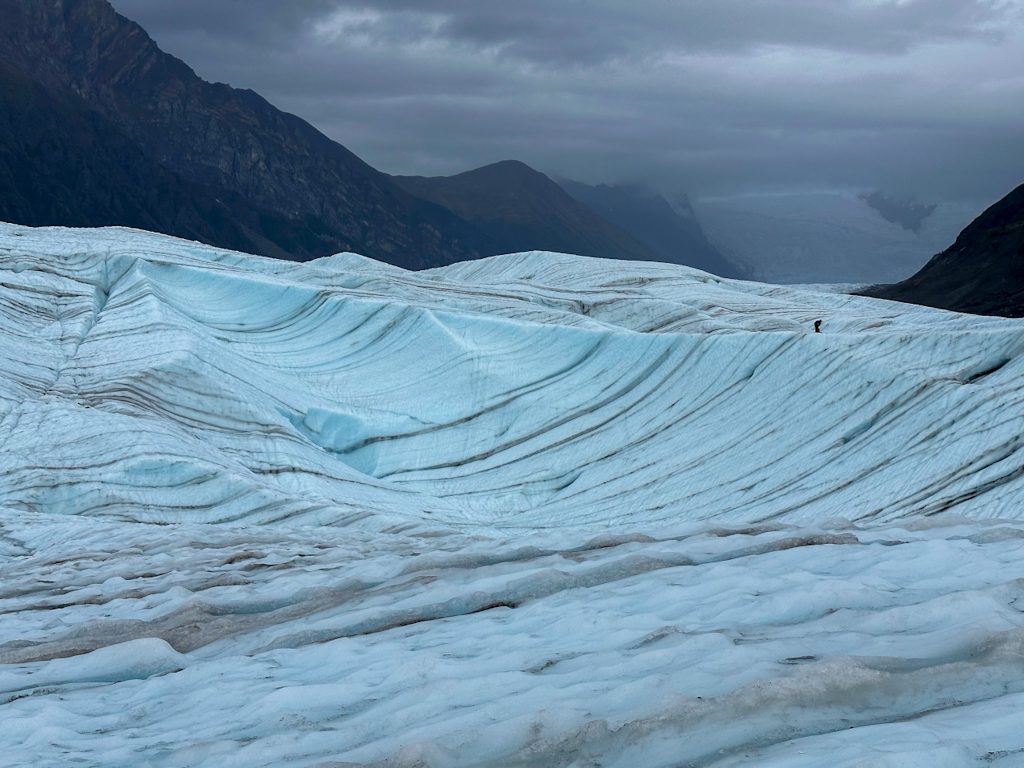
Crowd Sourced Questions - Van Life Alaska
We asked our community on Instagram their questions about Van Life in Alaska. Below are the most common ones along with our answers.
If you have additional questions, don’t hesitate to ask in the comments section of this blog post.
Can a RWD camper van do Alaska van life?
Yes! As mentioned above, there are endless campsites that are simply pull outs on paved roads. You can opt to stay in these. However, we caravanned with a friend in a RWD camper van for The Denali Highway. She only got stuck once and was able to self recover with the proper equipment: traction boards and deflating her tires.
This is the tire inflator we recommend as it does not overheat.
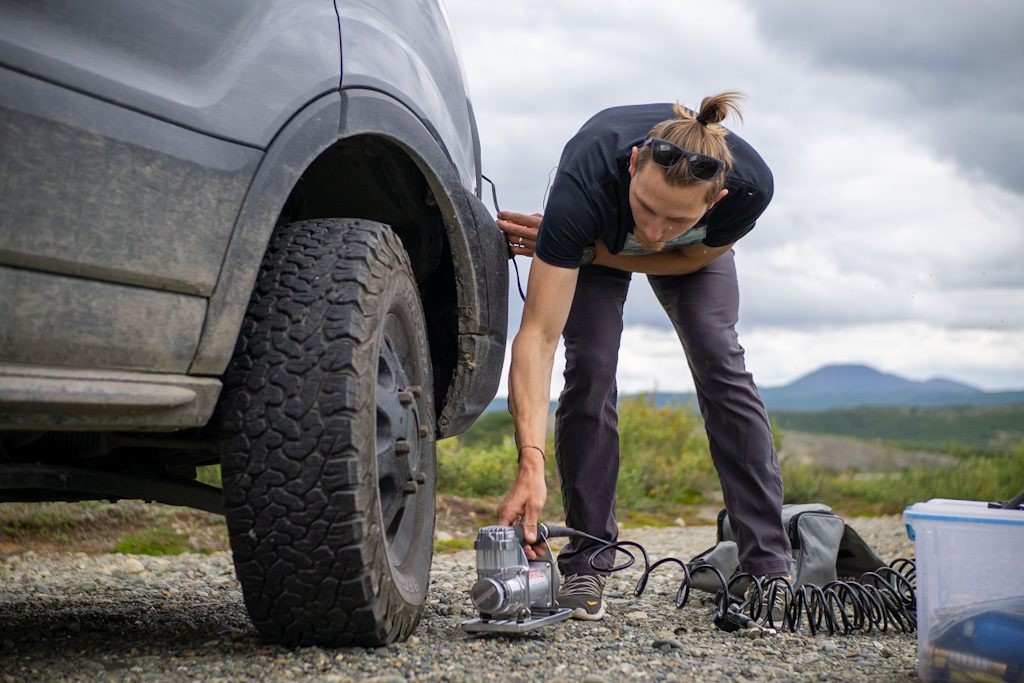
How much does it cost to do van life Alaska?
We compiled our entire Alaskan Van Life Summer costs.
Here are our stats for 2 people and 1 puppy over 10 weeks:
- Food: $3,111
- Groceries, coffee, eating out
- Excursions: $1,613
- Sea kayak tours, water taxis, deep sea fishing charter, guided excursions
- Transportation: $4,158
- Gas including trip up, insurance, oil changes
- Utilities: $753
- Internet, laundry, water fills
- Clothing: $301
- Other: $106
- Urgent care, gifts
- Total: $10,531 (about $1,000 / week)
What is the minimum length of trip we recommend coming from the Lower 48?
Most nomads take around 1 week on either end to get to and from Alaska. This can be shortened if you opt for the ferry. With travel times this extensive, you will want at least 2 weeks to experience Alaska. For optimal experience, we recommend at least 3-4 weeks of actually being in Alaska.
No matter how long your trip to Alaska is, you can optimize your experience by not rushing things. For example, if you only have 2 weeks, rather than try to see everything on your bucket list, pick one or two areas, experience them deeply and leave something to come back for!
Is a heater necessary for Summer / Early Fall in Alaska?
Below we have attached graphs of both Anchorage and Fairbanks average highs and lows through Summer and Early fall. Everyone has difference cold tolerances so heater requirements will vary. However, one benefit to having a heater in Alaska is to dry out all of your gear that is bound to get wet with all of the rain!


Final Thoughts - Van Life Alaska
We would go back to Alaska every single summer in our camper van if we could. It is truly the epitome and adventure, freedom, and vast beauty. If we haven’t convinced you yet, here are some final photos of our experience 🙂
And, please, do not hesitate to reach out if you have questions, or concerns. It is a big undertaking!




Thanks for being here! Happy building!
Eric + Colby
✉️ Join our mailing list for more content!
🙏🏽 If you are looking for more 1:1 van build help, we are here to help via Consulting or Travel Van Building.
[Start Here] Beginner Guides:
